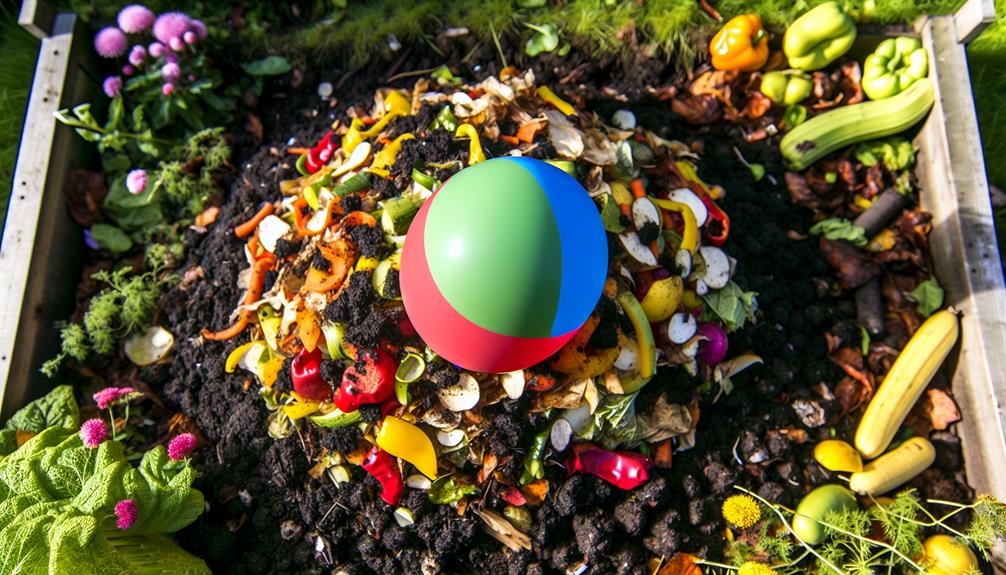

You can compost latex balloons, but foil balloons can’t be composted because they contain plastic and metal, which take decades to decompose. Latex balloons are biodegradable over time and are the better option if you’re aiming for an eco-friendly celebration. However, be aware that even latex balloons can take months to break down and aren’t perfect for quick composting.
Using sustainable alternatives like paper lanterns, reusable fabric buntings, or bubbles can greatly lessen environmental impact and make your events greener. Keep exploring for more ways to protect our planet!
When considering composting balloons, understanding the different types available is essential. You’ll mainly encounter latex and foil balloons.
Latex balloons are made from natural rubber, making them biodegradable and a better option for composting. They’ll break down more quickly in your compost pile, integrating nicely with organic materials.
On the other hand, foil balloons, often called Mylar balloons, are made from plastic and metal. These aren’t suitable for composting at all since they take decades to decompose and can harm the environment.
Knowing the difference between these types of balloons helps you make eco-friendly choices. Embracing this knowledge not only benefits your composting efforts but also connects you to a community dedicated to sustainability.
Understanding the materials used in balloons is key to making informed, eco-friendly decisions. Balloons are primarily made from latex or mylar.
Latex balloons come from natural rubber trees, making them biodegradable over time, but don’t be fooled—they can still take years to decompose.
You’ve probably seen mylar balloons at parties, known for their shiny appearance. Mylar is a type of plastic, meaning it doesn’t break down easily and isn’t compostable.
Knowing these differences empowers you to choose more sustainable options. By opting for latex over mylar, you’re helping reduce long-term waste. Engaging in these choices connects you with a community committed to protecting our planet, fostering a sense of unity and purpose.
When you think about composting balloons, you quickly run into the challenge of non-biodegradable materials, which don’t break down easily. This issue isn’t just inconvenient; it’s a real environmental concern because these materials can linger in landfills for years.

If you’re serious about eco-friendly practices, understanding these challenges is vital for making informed decisions.
Despite your best efforts, non-biodegradable materials like traditional balloons can pose significant challenges in the composting process. When you add items that don’t break down naturally, you risk contaminating your compost with substances that won’t decompose, making it less effective.
Traditional balloons are typically made of synthetic materials like latex or Mylar, which don’t easily break down in compost bins. These materials can linger for years, disrupting the natural composting cycle and potentially harming beneficial microorganisms.
To maintain a healthy compost, it’s important to carefully sort your waste and avoid adding non-biodegradable items. By staying vigilant, you maintain the nutrient-rich quality of your compost and promote a stronger sense of community responsibility and environmental stewardship.
You’ll face several environmental impact concerns when trying to compost balloons. First, most balloons are made from synthetic materials like latex and mylar, which don’t break down easily. These materials can persist in the environment, contributing to pollution and posing risks to wildlife.
When balloons end up in compost, they can release harmful chemicals, contaminating the soil and affecting plant health. Additionally, small fragments from decomposing balloons can be mistaken for food by animals, leading to ingestion and potential harm.
It’s important to recognize these challenges and seek eco-friendly alternatives. By understanding the environmental impact, you can make informed choices that promote sustainability and protect our planet. Let’s work together to create a greener future!
Eco-friendly celebrations can feature paper lanterns, reusable fabric buntings, or bubbles as alternatives to traditional balloons. Paper lanterns add a magical glow to any event, creating an enchanting atmosphere while being biodegradable.

Reusable fabric buntings, available in various colors and patterns, offer a vibrant and sustainable way to decorate. They can be used for multiple occasions, fostering a sense of community and consistency.
Bubbles bring joy and wonder, captivating guests of all ages without harming the environment. By choosing these alternatives, you contribute to a more sustainable world and inspire others to do the same.
Embracing these options not only makes your celebration unique but also aligns with a collective effort to protect our planet.
Creating sustainable celebrations is easier than you might think! You can start by choosing eco-friendly party supplies like reusable tableware and opting for biodegradable decoration alternatives such as paper banners and fabric bunting.
When planning a sustainable celebration, choosing eco-friendly party supplies can make a significant difference in reducing waste. Opt for reusable items like cloth napkins, bamboo cutlery, and stainless steel straws. These options not only cut down on single-use plastics but also add a touch of elegance to your event.
Look for biodegradable plates made from palm leaves or sugarcane, which break down naturally. You can also choose to decorate with items that double as keepsakes, like potted plants or seed paper invites that guests can plant later.
Frequently, biodegradable decoration alternatives offer a stylish yet sustainable way to celebrate while minimizing your environmental footprint. Think about how beautiful paper lanterns, fabric bunting, or potted plants can transform your space. Not only do these options look amazing, they’re also kind to the planet.
Imagine your guests feeling part of a community that values the Earth. You can use natural materials like wooden cutouts, dried flowers, or even edible decorations like fruit displays. These choices don’t just reduce waste; they create memorable, heartfelt moments.
Embracing biodegradable alternatives makes your celebration unique and eco-friendly. By opting for these, you’re showing that sustainability can be both beautiful and meaningful, fostering a sense of belonging and shared responsibility.
To host a sustainable celebration, prioritizing the reduction of waste from the outset is crucial. Start by choosing reusable or biodegradable decorations. Instead of balloons, opt for paper lanterns or fabric banners. Encourage guests to bring their own reusable cups and plates, or provide compostable ones.
| Item | Sustainable Alternative |
|---|---|
| Balloons | Paper lanterns |
| Plastic plates | Compostable plates |
| Disposable cups | Reusable cups |
| Single-use cutlery | Bamboo or wooden cutlery |
Curious To Read More Such Blogs:
Can You Compost Cotton Balls? The Shocking Truth Revealed!
Compost Mold Dilemma: Is It Worrisome or Worthwhile?
How to Start a Compost Pile: A Beginner’s Guide
By understanding the types and materials of balloons, you’ll see their environmental impact and the challenges of composting them.
Instead of traditional balloons, consider eco-friendly alternatives for your celebrations. They’re not only better for the planet but can also add a unique touch to your events.
Embrace sustainable celebrations and inspire others to do the same. Every small change makes a big difference, so let’s commit to making more environmentally conscious choices together!
